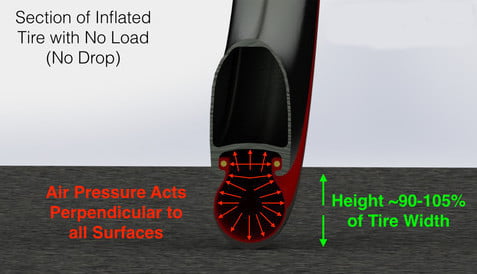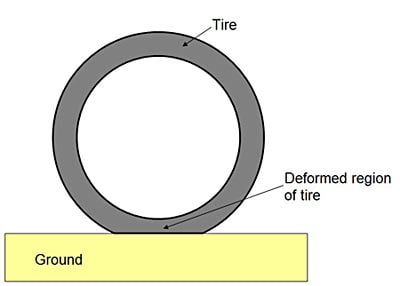This post answers a frequently asked question: “To what pressure should I inflate my bicycle tyres?” Related posts explain: “Slick bicycle tyres,” “Rolling resistance – are narrower tyres faster” and “Bicycle winter tyres.”
If you have any questions (or additions and corrections), please use the BikeGremlin forum:
www.bikegremlin.net
Table Of Contents (T.O.C.):
- What is the role of air pressure in tyres?
- What is the optimal tyre pressure?
2.1. What does the optimal tyre pressure depend on? - To what pressure should I inflate my bicycle tyres?
3.1. Rear tyre
3.2. Front tyre
3.3. Bicycle tyre pressure recommendations table - Effects of over and under-inflation
4.1. Pressure higher than optimal
4.2. Pressure lower than optimal
TL/DR
Here, I’ve explained:
- What is the optimal pressure for your tires (it depends on your weight and the tyre width)?
- Why is that important (harsh ride if it’s too high, pinch flats if it’s too low)?
- Should your front tyre run with a lower pressure (not always, not by much)?
1. What is the role of air pressure in tyres?
Tyres are filled with air in order to achieve several effects at the same time:
- Enough rigidity and firmness to allow good control and steering
- Lower weight
- Absorbing road irregularities (bumps, holes etc.)

The height of the tyre is about the same as its width.
When there’s no load pushing it against the ground, it stays at full height, the air pressure inside keeping it stretched.
2. What is the optimal tyre pressure?
Optimal tyre pressure is the one that allows the tyre to carry the weight without deforming too much, but so that the tyre is not too hard, making the ride harsh, and traction poor.

This enables it to comply with terrain irregularities, making the ride comfortable and grip better.
2.1. What does the optimal tyre pressure depend on?
It depends on two things:
- The total volume of the tyre
The bigger the air volume (larger wheel and/or wider tyre), the lower the pressure required. - Weight carried by the tyre
The bigger the weight carried by the tyre, the higher the pressure is required.
A typical example is a tyre with dimensions 622-23 (23 mm wide) that is inflated to pressures over 7 bars. On the other hand, a tyre with the same diameter, but 47 mm wide (622-47) is inflated to pressures below 4 bars – for the same weight carried.

The more volume a tyre has, the less air pressure is needed for it to carry the same weight.
3. To what pressure should I inflate my bicycle tyres?
Bicycle tyres usually have the maximum allowed pressure they can take written on their sidewalls. If the optimal tyre pressure, determined as explained in the remainder of this post, exceeds the tyres max. allowed pressure, you should look for wider tyres, or at least some higher quality ones of the same width (see which tyre widths fit which rim widths).
3.1. Rear tyre
The optimal pressure of the rear tyre is a 15% drop. What does this mean? Let me explain.
For a short “rough” recommendation, see chapter 3.3
First, both tyres are inflated to be firm (feel by squeezing with a hand). Then, the bike is loaded with luggage that it’s supposed to carry (if any). Finally, the rider sits on the bike. Then it is measured how much the rear tyre is compressed compared to its height when the bike is completely unloaded.

From 0 to 95%.
This can be measured visually – no need to use a ruler. The tyre should just slightly “bulge” at the place it contacts the ground. If it doesn’t deform at all, the pressure is too high. If it deforms too much, the pressure is too low.
The pressure at which there is a 15% drop depends on the load and tyre width. First, the tyre is inflated/deflated to achieve the 15% drop. Then the pressure is measured. This is the optimal rear tyre pressure.
3.2. Front tyre
After the optimal rear tyre pressure was determined, it is time to adjust the front tyre pressure. Which factors are important here?
In case of hard braking, or hitting a kerb, the front tyre takes the same load as the rear tyre, at least temporarily. That is why the front tyre shouldn’t be much softer than the rear tyre.
Still, for most riding conditions, the rear tyre takes generally more load. On road bikes, when a rider is leaned all the way forward, load distribution of front – to rear wheel is about 45% – 55%. For city bikes, where the rider sits almost upright, weight distribution is about 30% – 70%. This is why the front tyre can be a bit less inflated than the rear tyre, but shouldn’t be any more inflated.
Generally, the front tyre should be inflated to pressure about 10% lower than the determined optimal pressure for the rear tyre. For aggressive riding with often loading the front tyre, the pressure can be the same for the front as for the rear. For a laid-back riding style, or for city bikes, the front tyre can be inflated to pressure about 20% lower than the rear tyre pressure. Reducing pressure below this limit increases the risk of getting pinch flats (“snakebite“) when hitting a bump, or a kerb, as well as less control when braking hard (with the front brake).
3.3. Bicycle tyre pressure recommendations table
Since many people are looking for some “rough” pressure recommendation (at least as a starting point, to be modified with experience and using the method explained in chapter 3.1.), I’ve created a bicycle tyre pressure chart.
The chart is made for a rider and bicycle (with luggage) weighing 90 kg (~200 lbs). For each kg (~2 lbs) above 90 kg, increase the pressure by 1% (and for each kg below 90, decrease the pressure by 1%).
Likewise, the chart is given for 622 mm (28″ and 29″) size wheels. Increase the pressure by 7% for the 586 mm (27.5″) wheels (because their total air volume is smaller), and by 15% for the 559 mm (26″) wheels.
Bicycle tyre/wheel size standards
| Tyre width | Optimal pressure |
|---|---|
| 20 mm | 8.5 bar ~ 125 PSI |
| 23 mm | 7.5 bar ~ 100 PSI |
| 25 mm | 6.5 bar ~ 95 PSI |
| 28 mm | 5.5 bar ~ 80 PSI |
| 32 mm | 4.5 bar / 65 PSI |
| 37 mm | 4 bar ~ 60 PSI |
| 42 mm ~ 1.75″ | 3.5 bar ~ 50 PSI |
| 50 mm ~ 2″ | 2.5 bar ~ 35 PSI |
| 54 mm ~ 2.1″ | 2 bar ~ 30 PSI |
| 57 mm ~ 2.25″ | 1.8 bar ~ 25 PSI |
| 66 mm ~ 2.6″ | 1.4 bar ~ 20 PSI |
Of course, the optimal pressure depends on the riding surface, weight distribution, tyre type etc. This is just a starting figure to go by.
4. Effects of over and under-inflation
What happens if a tyre is inflated to pressure much higher than optimal? Or if it is deflated more than it should?
4.1. Pressure higher than optimal
These things will happen:
- The ride will become significantly less comfortable – since the tyres will not dampen road irregularities (bumps, even small ones).
- The energy put into pedalling to move forward will partially be wasted on small bouncing up and down. So speed on flats and climbs will drop slightly, for the same effort. On descents, speed will remain roughly the same.
- On extremely flat, good-quality pavement, speed will slightly increase compared to optimal pressure. Especially if tyres are of poor quality (bicycle tyre sidewall quality).
- Traction will be reduced, even on high-quality paved roads.
Inflating the rear tyre to pressure more than 5% over the optimal hardly makes any sense. As well as inflating the front tyre even 1% higher than the optimal pressure for the rear.
4.2. Pressure lower than optimal
- For the same effort, the bicycle will go slower. This goes for both climbs, flats and descents.
- On rough roads (very bad pavement, off-road, snow etc.), the ride will be a bit more comfortable. If tyres are fat enough to avoid pinch flats (a.k.a. snakebites), running a bit lower pressure is a good idea for bad roads.
- Tyre’s grip on rough roads (as well as climbing speed) will be a bit better (and faster).
However, even on rough roads, even for very wide tyres, there is a limit to how low it makes sense to go. The rear tyre can be inflated to up to 30% below the determined optimal pressure. Front tyre to up to 35% below.
Going further below those pressures further increases the risk of pinch flats, speed loss is higher even on rough roads, while there’s hardly any improvement in comfort or grip.
Last updated:
Originally published:
Related post – Are narrower tyres “faster” – rolling resistance:

If you have any questions (or additions and corrections), please use the BikeGremlin forum:
www.bikegremlin.net

